|
|
Armoured Fist Book Spotlight
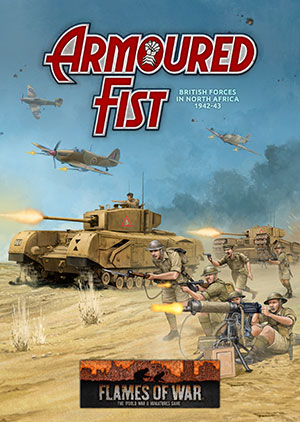 |
Armoured Fist Book Spotlight
With Phil Yates
Armoured Fist is the next step for the British Army in Flames Of War. It takes the forces from Desert Rats and expands them to include the Valentine and Churchill infantry tanks and the Sherman heavy tank, as well as a powerful rifle company and a few new support options.
For those of you contemplating a British force for the first time, the good news is that Armoured Fist contains everything that was in Desert Rats and much more, so you don’t need to find a copy of the older book to play. For those of you that already have Desert Rats, the good news is that if you take your old book into the shop when you buy Armoured Fist, you’ll receive one of the (if I may say so, pretty awesome) new Churchill tank sprues for free. Let’s take a look at each of these new features in turn.
Check out Armoured Fist in the online store here...
|
|
Infantry Tanks
The British Army fought the Second World War with two different classes of tanks, fast ‘Cruiser’ tanks for cavalry work, and heavy ‘Infantry’ tanks to support the infantry’s attacks. The two principal infantry tanks are the Valentine and the Churchill.
|
|
Valentine Tanks
The lighter and smaller Valentine fought in Africa from late 1941 right through to the end in Tunisia in May 1943. The basic version, the Valentine II has Front and Side armour of 6, so it’s pretty tough, backed up with the same 2 pdr gun found on the Crusader cruiser tank. To keep it small and cheap, the designers only fitted a small two-man turret, so it has the Overworked rule (which adds +1 to the score needed to hit when moving), and being an infantry tank, it’s rather slow. That ‘small and cheap’ though, means that it comes in at just over twice the price of the Crusader cruiser tank with twice the armour!
During the pursuit to the Tunisian border after the Battles of El Alamein, the British introduced small numbers of the upgunned Valentine VIII armed with a 6 pdr gun.
|
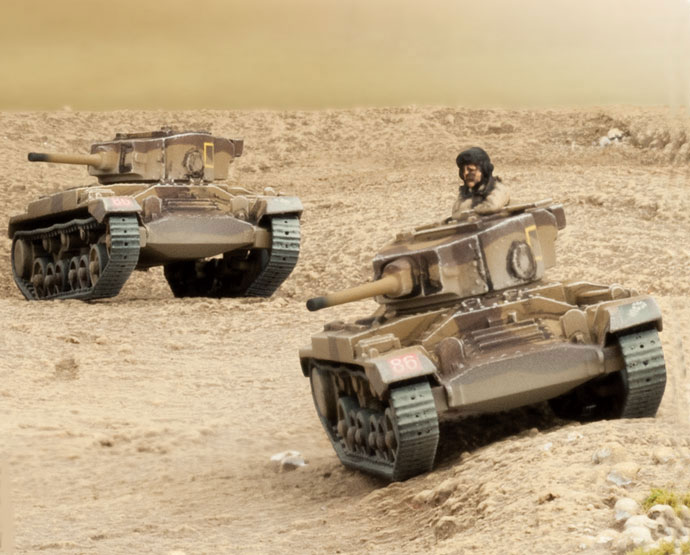
|
|
Up to a third of your tanks can be of this variety, giving you considerably greater anti-tank capability, at the expense of removing the tank’s machine-gun to squeeze the bigger gun in.
|
|
There’s four great ways to use this hardy little tank. You can field it as support for a rifle company (see below), giving them some cheap firepower that the enemy will have great difficulty knocking out. You can also field them as a full squadron of Valentines (or even a combination of both!) with an option in the Command Card pack to use the Charge! Card, to turn them into cruiser tanks, swapping speed and aggression for skill and clever tactics!
|
|

|
|
Death or Glory Boys
Finally, you can field your Valentines as the ‘Death or Glory Boys’, as the 17th/21st Lancers are known. While the armoured divisions in the Western Desert were equipped with the Crusader cruiser tank and new American gear like the Sherman, Grant, and Honey tanks, the 6th ‘Mailed Fist’ Armoured Division arrived in Tunisia with an unusual mix of Valentine and Crusader tanks.
|
|
With the Crusader being shipped to the fighting in the desert, the 6th ‘Mailed Fist’ Armoured Division trained in Britain on Valentine III tanks. These were like the Valentine II used in the desert, but with a bigger three-man turret that eliminated the Overworked problem. When offered Crusader tanks to replace their Valentines, they declined having come to appreciate the reliability of the Valentine and its toughness over the speedy, but lighter and less reliable Crusader. They did however accept some up-gunned Crusader III tanks with their 6 pdr guns (the Valentine VIII with the same gun being some ways in the future at that point).
|
|
The result is a rather dashing mix of well-armoured, but lightly armed Valentines supported by lightly-armoured but well-gunned Crusaders, all served with a good dose of cavalry dash and aggression!
|
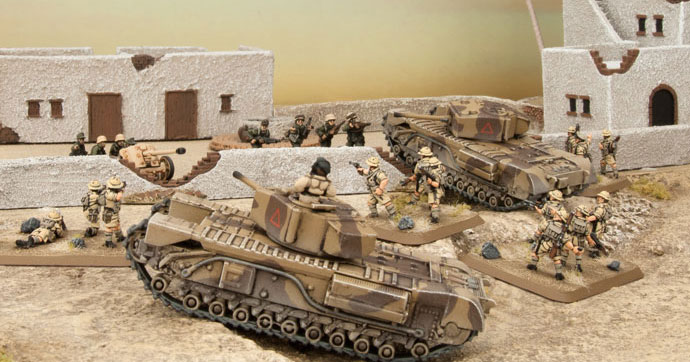 |
Churchill Tank
The Churchill tank is much bigger than the Valentine, and correspondingly better armoured and gunned. The Churchill’s armour is little thinner than the massive German Tiger tank, with Front 8 and Side 7, and like the Tiger its Top armour is 2. The majority of Churchill tanks have the latest, longer version of the 6 pdr gun giving them Anti-tank 10, and a good supply of the brand new 6 pdr HE round (they are infantry support tanks afterall, and need something to shoot up pesky German MG nests!).
|
|
This monster is almost impenetrable by most anti-tank guns and well armed, but it is also slow. It can move faster than the infantry it supports - just, sometimes. However, like the infantry, it can go almost anywhere without difficulty with its cross rating of 2+.
|
|
As is standard for British tanks, the Churchill also has a CS (Close Support) variant in the Squadron HQ for artillery support. This unusual tank replaces the turret-mounted 6 pdr gun with the smaller 2 pdr gun, and the hull machine-gun in the bow of the tank with a 3-inch howitzer!
All-in-all, the Churchill is a great tank for rolling forward onto an objective, obliterating everything that stands in your way. It can either do that as a small all-tank squadron on its own, or as support for a Rifle Company.
|
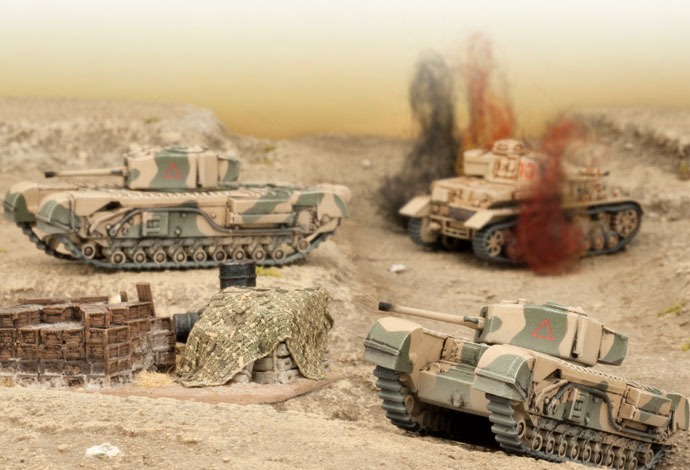 |
|
Infantry
Armoured Fist has two types of infantry formation: the Motor Company from Desert Rats, and a new Rifle Company.
|
|
Rifle Company
The heart of every British infantry division is its riflemen. Each rifle company has three large rifle platoons, and is backed by a huge variety of weapons from the battalion and brigade weapons companies. The rifle platoons have seven Bren Gun & SMLE rifle teams backed by a Boys anti-tank rifle and a 2-inch mortar. They are experienced and tough infantry who are particularly deadly and determined in assaults.
|
|
Backing them up are a dozen universal carriers (a sort of light, tracked scout car) in four patrols, up to six 3-inch mortars, up to eight 6 pdr anti-tank guns in two platoons, and up to eight Vickers HMGs in two platoons. Following standard British practice, the Vickers HMGs can also fire bombardments for the ability to reach out and touch someone just that little bit further away.
|
|
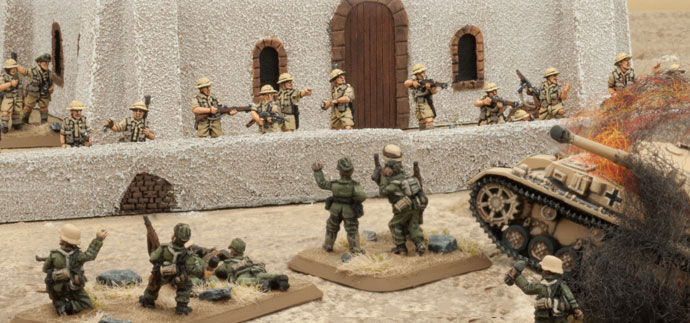
|
Dug in and backed by their machine-guns and anti-tank guns, these infantry can be very stubborn and hard to move. Their forte however, is attacking behind their supporting Churchill or Valentine tanks. With plenty of firepower to keep the enemy’s heads down (don’t forget their 25 pdr artillery in this calculation) and the tanks to deal with any particularly annoying machine-gun nests, they can walk onto the objective and assault almost anyone off to take their objective (and then hold it with their characteristic stubbornness).
|
|
For those wanting a bit more variety, the Command Cards allow you to customise your riflemen as Guards, Indians, Scots, ANZAC (Australians and New Zealanders), or South Africans. For a few extra points, these cards tweak the way your riflemen play.
|
|
Motor Company
If that many riflemen isn’t your thing, then the motor companies of the armoured divisions might suit better. These emphasise firepower over numbers. With just one or two small, but well-armed rifle platoons, they still have plenty of 6 pdr guns, universal carriers, machine-guns and a pair of mortars. Their job is to hold ground while the cruiser and heavy tanks attack. Place a motor company on one objective makes sure that the enemy won’t take it while you overwhelm the other with lots of tanks.
|
|

|
|
Heavy Tanks
That brings us back to tanks. This time, the heavy tanks of the armoured divisions: the Sherman and the Grant. These tanks gave the British an advantage in firepower at a time they were struggling to match the German panzers with their own equipment.
|
|
The Grant (which debuted in Desert Rats) arrived first for the Battle of Gazala. There its thick armour and hull-mounted 75mm gun gave the Germans a rude shock as they discovered that they no longer out-gunned the British.
|
|
The even more powerful Sherman tank turned up for the Second Battle of El Alamein. This tank was an improved Grant with a longer 75mm gun (with improved anti-tank capabilities) mounted in the turret instead of the hull, and even thicker armour (Front 6 rather than Front 5).
|
|
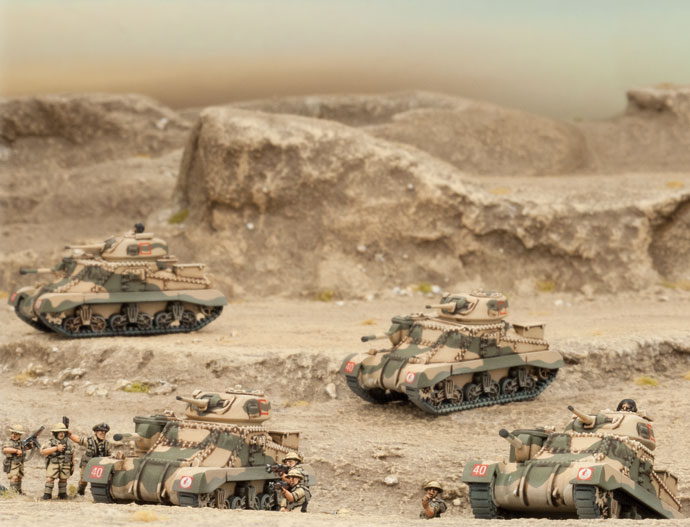
|
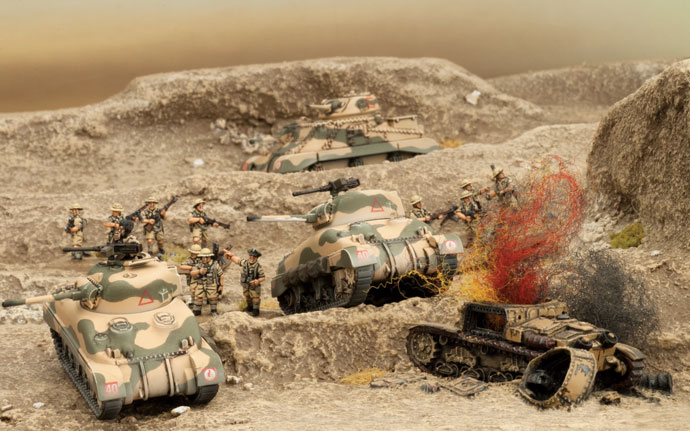 |
|
The Sherman armoured squadron gives you the option of fielding a purely Sherman-equipped formation, or one with a mix of tanks. You can replace up to half of your units with Grant units, or swap a Grant for one of the Shermans in each Sherman unit. This mix of heavy tanks balances out one of the few disadvantages of the Sherman - as such a powerful tank, it’s understandably expensive.
|
|
You can also increase your flexibility by fielding a Honey or Crusader cruiser unit in place of one of the Sherman units, or if you want to go the other way, a unit of Churchill tanks (from King Force at El Alamein) for really heavy support instead.
|
|
Like the cruiser tanks, the Sherman and Grant squadrons have been fighting the Afrika Korps for years, and, prior to El Alamein, suffered badly as a result. They are now more concerned with living to fight another day than with dying for victory today. As a result, their Last Stand rating is 5+, so you need to be careful about sustaining heavy casualties.
|
As Phil mentioned eariler, Armoured Fist contains everything that was in Desert Rats. If you're looking for info and tactics on how to use those units like the Grant, Honey and Crusader tanks you can find it all and more in the article below.
Learn more about Desert Rats here... |
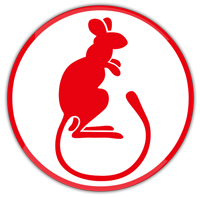 |
|
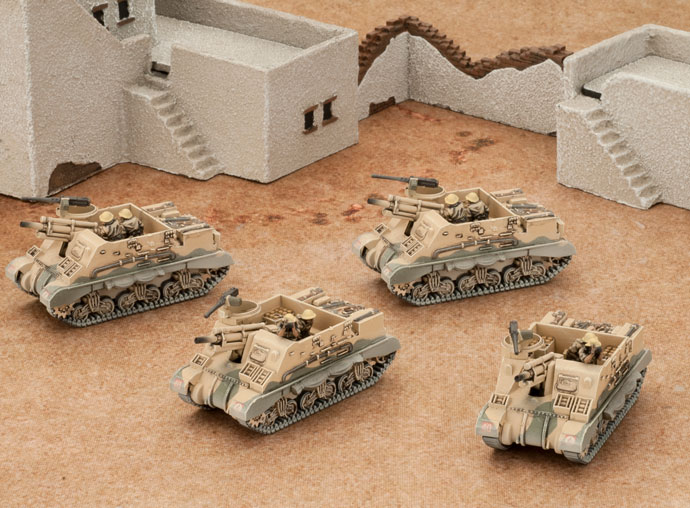
|
Support
One of the key features of British infantry tactics was their extensive use of artillery. Here you have the choice of the solid and reliable towed 25 pdr gun or the armoured self-propelled Priest. The choice between them depends on how you plan on fighting.
If your plan is a solid infantry assault, then the 25 pdr gives a relatively inexpensive option allowing you to get two good-sized units that can double as anti-tank guns if you are forced to defend. If your plan is for a more mobile armoured force, then you might want to consider the Priest.
|
|
It’s more expensive, but more able to look after itself, either relying on its armour or simply driving away from trouble - plus it’s got a big 105mm gun, so delivers a really solid bombardment. In a pinch, the Priest also makes a useful assault gun too.
The same 25 pdr chassis also mounts the 17/25 pdr heavy anti-tank gun. This big beast is not as small and survivable as the little 6 pdr gun, so not as good for holding an objective. However, it packs a solid Anti-tank 12 for knocking out the biggest and nastiest opposition at long range.
There are two types of armoured cars in Armoured Fist. The first is the Humber armoured car seen in Desert Rats. The Humber armoured car combines light armour with an excellent 15mm gun that is quite capable of knocking out any opposing armoured cars.
|
|
The second, new, option is the Daimler armoured car. This low sleek design mounts a 2 pdr gun (the same gun found on many tanks) in two out of three cars, while the third is a light scout car whose job is to probe ahead and look for trouble, covered by the bigger guns behind it. As you would expect, both types of armoured cars are sneaky, using the Scout rule to take maximum advantage of cover, and allow you to form a spearhead to move into No Man’s Land at the start of the game.
|
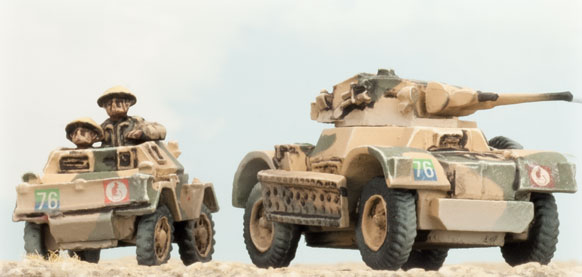
|
|
The Command Cards allow you to field armoured car companies of both types, and as an extra bonus, a Yeomanry armoured car squadron from the 6th ‘Mailed Fist’ Armoured Division with a mix of all three types!
|
|
Armoured Fist also gives you two choices of aircraft. You can either field the cannon-armed Hurricane tank-busters, or the bomb-armed Kittyhawk (known as the P-40 Warhawk to the Americans). This allows you to pick the type of air support that best suits your needs.
|
|

|
|
Armoured Fist Is Here
The new Armoured Fist book makes the British Army the most versatile of all. Not only does it have a wide variety of tanks of its own, but it also has all of the American tanks as well. These are backed up by really solid infantry and artillery to produce a force capable of many play styles. No matter how you prefer to fight, the British Army has something for you.
~Phil
|
|
|